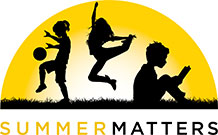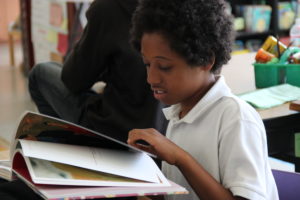Cracking the Code to a Successful Summer Reading Program
What could happen when students are engaged with just-right, high-interest books over the summer months? At Orange County Public Schools (FL), a six-week summer reading academy increase average Lexile scores by 44%. In the summer of 2015, South Berwyn, Illinois, a district where 100% of students are eligible for free or reduced lunch and 90% are English language learners, defied the odds and not only avoided summer slide but experienced a significant increase in reading proficiency.
These schools have cracked the code in creating summer reading programs that combat summer slide by triggering curiosity and engaging students. Providing customized reading lists, offering unlimited access to digital and print books, and engaging the community can dramatically reduce and even eliminate the long-term impacts of summer learning loss.
How the Income Gap Becomes a Learning Gap
More than 100 years of research on the phenomenon of summer learning loss confirms that on average, low-income students lose more than two months in reading achievement while their middle-class peers actually make slight gains. The Faucet Theory explains that, when in school, all students have equal access to books, meals, caring teachers, and structured activities that create an environment where each child has the opportunity to flourish. However, over the summer months, the faucet of learning continues to flow for students living at higher income levels, but is essentially turned off for low-income youth.
Summer learning loss has gained national attention in major media such as Time magazine, Forbes, The New York Times, and USA Today, all of which highlight student consequences beyond simply losing a few months of knowledge. Over time, these lost months add up to years, making summer learning loss a driving factor in drop-out rates for low-income students. The opportunity and achievement gap has proven to grow wider and wider for low-income students during the summer months. This cumulative deficit sometimes leaves students an entire grade level behind.
Malcolm Gladwell said it best in his book Outliers: The Story of Success: “Virtually all of the advantage that wealthy students have over poor students is the result of differences in the way privileged kids learn when they are not in school…. America doesn’t have a school problem. It has a summer vacation problem.”
Research shows summer programs offering access to books and structured educational activities can reduce, prevent, and even reverse summer learning loss. Costs ranging from $288 to $600 a week per student put these programs out of reach for the vast majority of low-income families and many middle-income families. Nationally, only one third of households report having at least one child enrolled in a summer program. As a nation, we have to get more creative about providing low-cost, free, or affordable summer learning opportunities on a larger scale.
The Summer Opportunity Project
The national concern about summer learning loss has made its way to the nation’s capital, prompting a creative partnership called the Summer Opportunity Project, a collaborative effort between the White House and the National Summer Learning Association (NSLA). This initiative involves 10 federal agencies, including the Departments of Education, Agriculture, Labor, Housing, Health, and more. The mission of the partnership is to support the learning, wellness, and developmental needs of our youth by expanding access to affordable summer learning opportunities, healthy meals, and youth employment opportunities.
As part of the initiative, NSLA has created a complimentary Summer Action Toolkit, a step-by-step guide to help schools, districts, and communities maximize the summer months for their youth. The guide, along with the new Summer Funding Resource Guide, highlights readily available resources, ideas on how to get the community on board with summer learning, and specific tools to help state and local leaders identify the most promising path to meet the needs of young people during the summer.
myON‘s personalized literacy environment was recognized as a critical tool for providing unlimited, on-demand digital access to just-right books outside the school year. For three months of the year, school libraries and resources halt in many districts, and many low-income students go home to “text-free zones” where they have little to no exposure to books, magazines, or anything else to read. Losing access to books that match their interests or prompt curiosity can turn kids off to reading altogether.
Why Interest and Text Complexity Matter
The average time kids spend reading in the summer is only about six hours (even less for boys), and personalizing a student’s experience is a contributing factor to increasing that time. The concept seems simple: Increased access to a wide variety of fiction and non-fiction books plus a plethora of reading levels equals student choice. Giving students a choice, in turn, generates more interest in reading.
More than 20 state departments of education use Lexile measures to encourage targeted reading, a metric for reading ability and text complexity. The measurement is designed to match students to books that fit their unique abilities. If books are too difficult, students may get frustrated and read less or not at all. If books are too easy, students aren’t exposed to new vocabulary or complex sentence structures that challenge them appropriately to improve reading levels.
“To improve any skill, deliberate practice is important,” said Malbert Smith, Ph.D., and co-developer of Lexile measures. “A student isn’t going to want to practice if he or she struggles to understand a book and doesn’t see progress in his or her abilities. Lexile measures are used to help students engage in meaningful practice that fosters motivation and accelerates learning.”
Many schools create summer book lists with 10-20 books, not giving students much of an option when it comes to interest and reading level. Parents have to either purchase these books or see if their public library has access to them. With 24/7 access to digital books, teachers and students are able to fill their virtual backpacks with a long list of texts matching personal interests and reading levels.
Finding just-right books can be as easy as asking students what they’re interested in, whether it be sports, the arts, a favorite subject in school, or nature. Leading learners to the right books for them has the potential to spark a love for reading and foster learning that will continue through the summer and throughout their lives.
Creating a Community-wide Initiative
Hillsborough County, Florida, is a prime example of creating a community of readers by pulling together local businesses, government officials and boards, non-profit organizations, and the school district to promote reading in and out of school. The “Read on myON” initiative to improve summer literacy grants unlimited digital access for 244,000 students from birth to 8th grade. The community is constantly buzzing with the newest content, contests, and prizes available to those engaged in reading. In 2015, Hillsborough read more than 300,000 books in June, and racked up 40,000 hours (that’s 4.5 years) of reading during the summer. Dramatic Lexile gains have motivated Hillsborough to renew the summer program for the sixth year in a row.
In Valdosta City Schools (GA), summer reading lists are mammoth and include a sneak-peek that allows students to read informational and fictional text about upcoming topics for the coming school year.
In all of these successful districts, parents have a large impact on getting their children to read outside of school. Leading by example, reading with their kids, and asking questions about what they’re reading encourages students to grab a book instead of a video game on the next rainy day. With customized reading lists, community involvement, and unlimited digital access to books, summer learning loss can become a thing of the past for communities across the nation.
Sarah Pitcock joined the Center for Summer Learning in 2006 and held progressive leadership roles in research and training prior to being appointed CEO of the National Summer Learning Association in 2013. A leading expert on summer learning research, practice, and policy, Pitcock has championed summer learning through testimony and presentation to legislative and policymaking bodies. She has authored white papers, practice guides, op eds, and blogs on the subject.
Todd Brekhus is the president of myON, a business unit of Capstone, which offers a personalized reading environment that matches students’ interests and reading levels and tracks their reading growth. Prior to joining Capstone, Brekhus held executive positions in a range of education businesses, and spent eight years as an English teacher, department chair, and technology director. You can connect with him on Twitter here.
This blog originally appeared on EdWeek.




